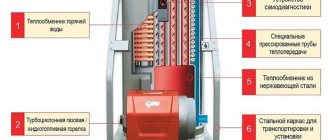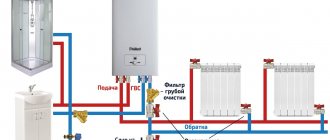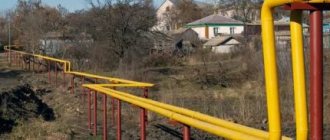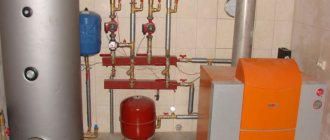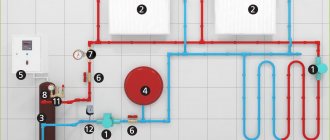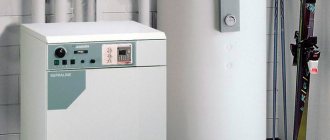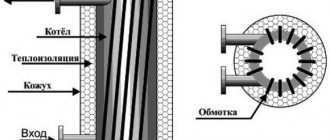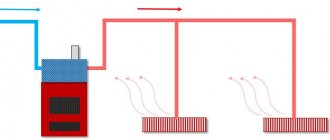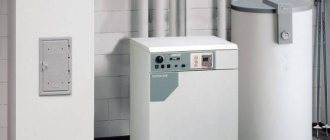Application of combi boilers
Today, such devices are universal and at the same time economical devices for autonomous heating at home. Their main trump card is that they are not tied to one type of fuel. If such a boiler runs on electricity, then during a sudden power outage you can light the wood stove to keep the house warm and vice versa.
Buying a combination boiler solves several problems :
- If there is no main gas pipeline in the village where the house is built, then it is possible to use two alternative types of energy at once - solid fuel and electricity.
- If a country house is connected to a weak power supply line, a combination boiler is almost an ideal option - you won’t have to freeze if you need to turn on another powerful electrical appliance for a long time.
- Eliminates cooling of the house when using solid fuel. Such a unit, connected to water heating, helps maintain a constant temperature in the system: if the fuel burns out, the boiler will automatically smoothly switch to heating through the heating element. This is especially convenient at night: you don’t have to get up and add wood to the stove’s firebox.
When a conventional boiler cools down, it must be lit immediately so as not to lose heat Source iobogrev.ru
What to look for when choosing a combination boiler for heating a private house
There are many factors to consider before choosing a combi boiler:
- single- or double-circuit - according to the configuration of the heating system of a private house;
- power - calculate based on the size of the home and its thermal insulation;
- take into account the economic component;
- the fuel used according to the availability of one or another type of energy carrier, both main and additional;
- the presence of a chimney depending on the structural characteristics of the building.
And these are not all the nuances that determine the model of a combined boiler. By contacting professional consultants, you can avoid unnecessary expenses, select the right model and ensure warmth and comfort in your home at any time of the year.
Principle of operation
The wood-electricity combination boiler operates according to the following algorithm :
- Melting and heating of the unit occurs in the traditional way. During the combustion of solid fuel (wood, coal, briquettes), the water temperature is maintained using a thermostat together with a sensor. Electric heating elements do not work at this moment.
- If you do not add fuel to the firebox in time, then after it burns out, the temperature of the water in the system gradually decreases to a certain value, after which a sensor is triggered, which closes the control contacts and the heating element (one or more) turns on. From this moment on, the boiler begins to operate from the mains.
- After the next loading of fuel, the water in the pipes is heated from the side of the firebox and, upon reaching the set temperature, the sensor is triggered again, but this time to turn off the heating elements. The electrical part of the boiler is again inactive until the water temperature decreases again.
Most often, the electric heater in a combination boiler is designed as an auxiliary heating device, but if you wish, you can choose a boiler model that, if necessary, can work continuously, providing hot water to the house and heating system.
A heating element with a sensor connected to a heat exchanger Source anapasunsity.ru
Design Features
The range of heating boilers is represented by different models. Some run on gas, others on electricity, and others on liquid fuel. Each type has its own operational advantages and disadvantages. The disadvantages of using certain installations haunt designers and technicians. So they decided to combine some models, and combined heating devices were born. They can operate, for example, on solid fuel and gas simultaneously.
This combination made it possible to minimize emergency risks and organize the operation of the same solid fuel boiler in autonomous mode. How do such installations work, and where is their use more than justified? As a rule, universal boilers are always equipped with an additional number of pipes. They can be used to connect underfloor heating, heating radiators, a greenhouse control system, heating water in a swimming pool or heating a bathhouse.
The gas burner in such a boiler is located below the combustion chamber, where firewood, briquettes, sawdust or coal are placed. Therefore, if necessary and switching, it allows you to completely burn the remaining solid fuel. If work is switched to solid fuel, the gas burner closes automatically. For ease of use, the steel heat exchanger responsible for heating the room passes through the entire body. All walls are thermally insulated with special mineral wool, so the efficiency of the unit is almost 92%. And this is a very high figure.
The heat exchanger for supplying hot water is made of copper and is located in the upper part of the installation. Copper is not afraid of corrosion, so the service life of the coil is equal to the service life of the entire device as a whole. Universal boilers have lever and air dampers that ensure the supply of the required portion of air.
How the installation works
The operating principle of a gas-wood boiler is extremely simple. The design uses two autonomous cameras. The furnace room is located above the gas room. This feature allows you to use two types of fuel simultaneously. Gas burners can operate at low pressure. Therefore, you can often see models that are connected not to central gas lines, but to liquefied gas cylinders.
Note! If there is a power outage, the gas-wood boiler will not be able to operate on gas. And all because the products of its combustion in this case will not be independently discharged through the chimney to the outside, and condensate instantly accumulates on its walls, clogging the chimney. If there is no light in the house, the boiler is heated exclusively with wood
If there is no light in the house, the boiler is heated exclusively with wood.
Advantages of installations
There are quite a lot of advantages of gas-wood boilers, so we will outline only the most basic ones:
- The main factor is the opportunity to save money and use cheap firewood instead of expensive blue fuel. If you run out of wood, you can switch to gas in automatic mode.
- The combined design allows the use of autonomous heating. Gas ensures operation of the installation at night without additional fuel loading. It’s also nice to come home after work to a well-heated house, knowing that the gas will maintain the desired temperature when there is no one to throw firewood into the stove.
- Universal combi boilers can have one or two circuits, so you can use the installation not only for heating, but also for supplying hot water for technical needs. Today, universal gas-wood boilers are equipped with storage boilers, and there are models that can heat water to the desired temperature using a flow-through method. The choice is great, and that makes me happy.
But before deciding to purchase such installations, experts recommend studying the features of their operation and disadvantages.
Pros and cons of combi boilers
When choosing any equipment, you need to focus not only on its positive aspects, but also study its disadvantages in order to understand which characteristics are more important to you.
Advantages
The advantages of wood-electricity devices compared to heating units that operate only on one type of fuel are obvious:
- Versatility of equipment. Electricity for a boiler can be either the main energy source or an auxiliary one - which priority will be decided only by you.
- Autonomy . There is no need for constant monitoring, since the boiler is equipped with automation.
- Economical . Firewood is one of the most affordable types of fuel in many regions of the country, and it is now almost impossible to find a house without an electrical connection.
- Convenient design . Constantly maintaining the set water temperature with minimal energy consumption.
- If a two-tariff meter is installed, you can program the boiler to turn on the heating elements only to maintain heat at night, when the tariff is much lower and thereby save electricity consumption .
With proper load distribution, a two-tariff meter saves from 30 to 65% on electricity bills Source zinoti.lt
- Long service life . Such boilers, when properly operated, operate for up to 25 years.
- The production of models with built-in pipes for the possibility of connecting a “warm floor” system .
Important! Wood-electric boilers operate effectively even in low-power modes.
Flaws
With all the advantages, such boilers also have disadvantages:
- Separate room . Units of this type require their own boiler room and an extension for fuel storage.
- Heavy weight . Most often, boilers are made of cast iron and require a solid concrete base to place it on.
- Device complexity . This factor affects the price of the boiler: it is 20-30% higher than the cost of units operating on one fuel.
On a note! Electric heating elements of most combination boilers are designed mainly to maintain heat. In winter, at external temperatures below –5 °C, they cannot completely replace the combustion of solid fuel due to their low power. If you plan to use electric heaters for a long time, you need to look for boiler models that operate on three-phase power (if this is installed in the house).
Powerful boilers are connected to a three-phase network Source tk-assortiment.ru
Design Features
The range of heating boilers is represented by different models. Some run on gas, others on electricity, and others on liquid fuel. Each type has its own operational advantages and disadvantages. The disadvantages of using certain installations haunt designers and technicians. So they decided to combine some models, and combined heating devices were born. They can operate, for example, on solid fuel and gas simultaneously.
This combination made it possible to minimize emergency risks and organize the operation of the same solid fuel boiler in autonomous mode. How do such installations work, and where is their use more than justified? As a rule, universal boilers are always equipped with an additional number of pipes. They can be used to connect underfloor heating, heating radiators, a greenhouse control system, heating water in a swimming pool or heating a bathhouse.
The gas burner in such a boiler is located below the combustion chamber, where firewood, briquettes, sawdust or coal are placed. Therefore, if necessary and switching, it allows you to completely burn the remaining solid fuel. If work is switched to solid fuel, the gas burner closes automatically. For ease of use, the steel heat exchanger responsible for heating the room passes through the entire body. All walls are thermally insulated with special mineral wool, so the efficiency of the unit is almost 92%. And this is a very high figure.
The heat exchanger for supplying hot water is made of copper and is located in the upper part of the installation. Copper is not afraid of corrosion, so the service life of the coil is equal to the service life of the entire device as a whole. Universal boilers have lever and air dampers that ensure the supply of the required portion of air.
How the installation works
The operating principle of a gas-wood boiler is extremely simple. The design uses two autonomous cameras. The furnace room is located above the gas room. This feature allows you to use two types of fuel simultaneously. Gas burners can operate at low pressure. Therefore, you can often see models that are connected not to central gas lines, but to liquefied gas cylinders.
Note! If there is a power outage, the gas-wood boiler will not be able to operate on gas. And all because the products of its combustion in this case will not be independently discharged through the chimney to the outside, and condensate instantly accumulates on its walls, clogging the chimney
If there is no light in the house, the boiler is heated exclusively with wood.
Advantages of installations
There are quite a lot of advantages of gas-wood boilers, so we will outline only the most basic ones:
- The main factor is the opportunity to save money and use cheap firewood instead of expensive blue fuel. If you run out of wood, you can switch to gas in automatic mode.
- The combined design allows the use of autonomous heating. Gas ensures operation of the installation at night without additional fuel loading. It’s also nice to come home after work to a well-heated house, knowing that the gas will maintain the desired temperature when there is no one to throw firewood into the stove.
- Universal combi boilers can have one or two circuits, so you can use the installation not only for heating, but also for supplying hot water for technical needs. Today, universal gas-wood boilers are equipped with storage boilers, and there are models that can heat water to the desired temperature using a flow-through method. The choice is great, and that makes me happy.
But before deciding to purchase such installations, experts recommend studying the features of their operation and disadvantages.
Recommendations when choosing a boiler
Today the market offers a wide range of universal boilers, which differ in power, performance, design and configuration. But before purchasing such a unit, you need to weigh the pros and cons, and it is also useful to listen to the recommendations of professionals in this matter.
When purchasing a boiler, you must consider the following:
- Power . It depends on the fuel that will be a priority.
- The volume of one fuel load and the size of the combustion chamber . The duration of firewood burning depends on this parameter.
- Firebox material . These parts are made of cast iron and steel. It is preferable to choose chambers made of cast iron, since they are not subject to deformation when heated and retain heat longer, unlike a steel exchanger.
Components for combined boilers Source winplast.ru
- Grate bars . Two types are used: standard cast iron and the same, but coated with ceramic. The latter are used mainly for bulk materials, which consume more oxygen during combustion, and accordingly, the temperature is created higher.
- Weight and size . Typically, the body of such boilers is made of cast iron, which makes them much heavier than their “brothers”.
Advice! When buying a heating device, you need to take into account the area of the house. You should not purchase a boiler “with a power reserve”, as this will entail an overpayment - both during purchase and during operation.
Installation Requirements
Combination boilers in accordance with SNiP 41-01-2003 must meet the requirements. At the same time, they have their own characteristics during installation and operation, which distinguish them from similar units operating on a single fuel.
These requirements and recommendations must be known and followed in order for the boiler to operate safely.
Premises requirements
Wood and electric boilers for home heating are produced only in a floor-standing version and are installed in a boiler room with ventilation, and in accordance with other SNiP requirements:
- The walls in the room are made of non-combustible material.
- Equipment in the boiler room is installed no closer than 300 mm from the walls.
Example of boiler installation Source pingru.ru
